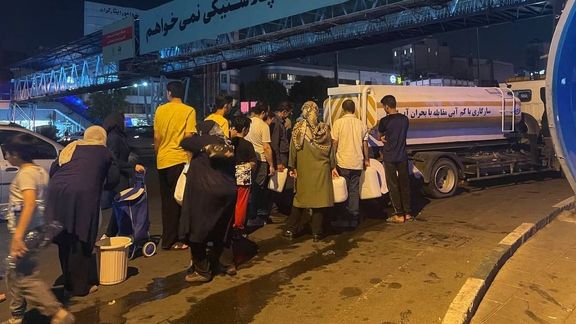Water Outage Continues As Iran Officials Claim It Ended

Officials including minister Ali-Akbar Mehrabian on Wednesday claimed that outage of drinking water in Tehran has completely ended but evidence indicates otherwise.

Officials including minister Ali-Akbar Mehrabian on Wednesday claimed that outage of drinking water in Tehran has completely ended but evidence indicates otherwise.
Mehrabian said that water treatment facilities have resumed operations since Tuesday evening and are working at full capacity. “We are trying to raise the water pressure back to the normal level gradually,” he said. But videos on social media showed tankers distributing water to residents on Wednesday.
Drinking water outage which started in some districts of the capital Tehran Friday has impacted not only households but also many businesses, particularly restaurants. Beside regular household use, the outage has disrupted the use of cooling systems in houses when often near 40 degrees Celsius during the day at this time of the year.
Videos sent to Iran International TV by citizens indicate that outage or low pressure has continued in some of the areas of the capital. They also say water tankers are still distributing water in various neighborhoods.
Reports from Tehran also indicate that bottled water has vanished from shelves in some areas of the capital and the price has gone up too.
The water outage started when torrential rains flooded rivers and caused extensive landslides in various areas of the country including around the capital where riverbeds were completely blocked by debris from the mountains.
Karaj, the capital of Alborz Province, which is a city of over 1.6 million only about 40 kilometers (25 miles) to the west of Tehran has also been affected by the outage.
Some citizen reports on social media indicate that the outage has continued in some areas of the city despite officials’ claims that it ended at midday Monday.
Many citizens have expressed anger on social media over lack of accountability by the water supply network officials who did not provide timely warnings to citizens and repeatedly claimed the outage would end within hours.
Water shortage has been threatening the Iranian capital of 10m for years. Causes include drought and the massive waste of water due to the dilapidation of the distribution infrastructures.
Iran has been suffering from drought for at least a decade and officials have been warning of a further decrease in precipitation. The volume of water in the five dams that supply Tehran, for instance, has consistently been going down in recent years.

Mohammadreza Bakhtiari, the former CEO of Tehran Water and Sewerage Company, said in early April that about 20 percent of drinking water in Tehran, as much as 300,000 cubic meters, goes to waste before reaching households and businesses.
In recent years, massive protests have occurred in several cities against government mismanagement of water resources, harmful dam building, and politically motivated diversion of rivers that have devastated agriculture and drinking water sources in many areas.
In July 2021, water protests erupted in several cities in the oil-rich Khuzestan province that ended with the forceful intervention of police and the Revolutionary Guards. More than ten people were killed and hundreds detained during the protests that lasted a week.
In November of the same year, thousands protested in Esfahan over lack of water for agriculture where the iconic Zayandeh-Roud river has turned into a dry bed over the past few years. The protests soon turned into anti-government unrest.